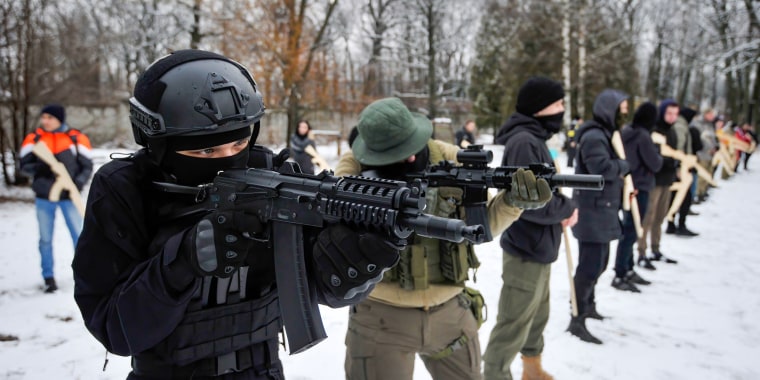Russia’s Feb. 24 invasion of Ukraine prompted Ukrainian President Volodymyr Zelenskyy to later call on all “citizens of the world” to join the fight against the Russian army and help defend “peaceful coexistence.” Thousands appear to be taking up the cause, including dozens of Americans and Canadians.
Among the well-meaning citizens lining up to fight for Ukraine are volunteers with links to white supremacist and far-right extremism.
But among the well-meaning citizens lining up to fight for Ukraine are some global volunteers with links to white supremacist and far-right extremism. In recent years, global neo-Nazi and white supremacist extremist foreign fighters have sought training and combat experience by joining ultranationalist defense militias in Ukraine. A member of the U.S. neo-Nazi group The Base, an ex-Marine, joined the Ukrainian war effort in 2020 before he was expelled from the country.
Factions of Ukrainian fighters have been linked to white supremacist or neo-Nazi movements over the past eight years, including some members of the ultranationalist Azov Battalion, which fought against pro-Russian separatists in Ukraine in 2014 and eventually became a volunteer arm of the National Guard of Ukraine. As the conflict with Russia escalated last week, Azov members posted a video of themselves greasing bullets in pig fat and warning Russian Muslim soldiers, likely those from Russia’s Muslim-majority Chechnya, that they “will not go to heaven.”
Putin has exaggerated the fact that a small minority of Ukrainian fighters have ties to far-right extremism in his attempt to describe all of Ukraine as in need of “denazification,” which is patently false. While there are problems with far-right groups and far-right violence in Ukraine, as there are in other parts of Europe, there is little support among the broader population for right-wing nationalist parties, which garnered only 2 percent of the national vote in 2019. Ukrainian President Zelenskyy, who is Jewish, lost family members in the Holocaust.
Even among foreign fighters traveling to Ukraine, the vast majority have no ties to white supremacist extremism. And even within the far right, motivations for joining a foreign conflict vary. Previous research on extremist right-wing foreign fighters has found that some are “war junkies” and adventurers or joined because they sought career changes as fighters in a new country.
But the conflict has clearly created an opportunity for extremists to recruit white supremacist foreign fighters who seek training and networks or seek to intensify their engagement to the cause in other ways. Far-right militia leaders in Europe have responded to the Russian invasion of Ukraine by raising funds online, recruiting fighters and planning travel to the front lines, activities the SITE Intelligence Group has described as an “outpouring of support for Ukraine” from “numerous far-right white nationalist and neo-Nazis groups” across Europe and North America.
There are also risks of fighters becoming radicalized once overseas and returning to their home countries with additional military training and tactical combat skills. There is already a documented history of this happening in Ukraine, in ways that have been described as creating a “hub in the transnational white supremacy extremism network.”
Far-right militia leaders in Europe have responded to the Russian invasion of Ukraine by raising funds online, recruiting fighters and planning travel to the front lines.
To be clear, the global far right is by no means unified in support of Ukraine against Russia. Many among the American far right admire Putin’s authoritarian and anti-Western, anti-feminist and anti-LGBTQ+ stances. My research team at American University’s Polarization and Extremism Research and Innovation Lab has noticed in online white supremacist extremist channels an increased sharing of antisemitic conspiracy theories about a so-called “Jewish plot” against Russia or a “Jewish war” that pits whites against whites.
Counterterrorism officials are paying attention to the increased risks posed by volunteers from across the globe making their way to Ukraine. After “at least half a dozen known neo-Nazis traveled to the Ukraine” from the U.S. and Europe in early February, counterterrorism authorities in the United Kingdom introduced additional questioning about the purpose of travel for anyone departing the U.K. for Ukraine. Such screenings are also needed at other international departure sites.
The world has seen unprecedented support for Ukraine over the past week, including some political support for global volunteers. U.K. Foreign Secretary Liz Truss, describing the war as a “battle for democracy,” said she supports foreign fighters who choose to go to Ukraine from the U.K. Latvian lawmakers voted unanimously on Feb. 28 to permit Latvians to fight in Ukraine.
Such foreign fighters clearly take on tremendous risk to their personal safety, leading some countries to issue warnings against travel. Referring to Ukrainians, White House principal deputy press secretary Karine Jean-Pierre said Wednesday, “We applaud their bravery. However, our travel advisory remains U.S. citizens should not travel to Ukraine.”
But as nations and citizens around the world scramble to intervene and restore peace in Ukraine, we should remember that the risks of foreign-fighter engagement are not only about those individuals’ safety. The conflict in Ukraine also raises serious risks for recruitment, radicalization and mobilization in violent white supremacist extremist movements — in ways that may ripple outward long after this horrific conflict is resolved.

